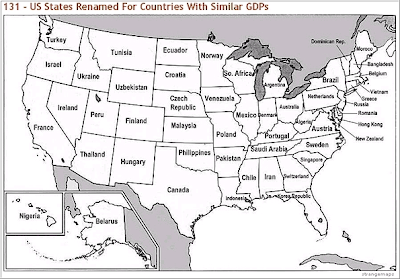Reader Tom submitted the following chart which shows the economic output from all U.S. states compared to the rest of the world. While I can’t vouch for the accuracy it nevertheless still confirms that the U.S. is still the big dog on the block; it’s an interesting way to look at the globe (click on graph to enlarge):
“In the midst of a housing collapse and credit crunch, the impending doom of the U.S. economy is taken as gospel. But look behind the headlines, and the numbers tell a different story. The U.S. economy grew by 3.9% in the credit turmoil-ridden third quarter — following a 3.1% jump in the second quarter. That means that the United States added the equivalent of a new Saudi Arabia to its economy just since the beginning of April. And the fact that the World Economic Forum ranked the U.S. econom y the most competitive economy in the world last week got little press. And even when it did, the #1
ranking of the United States was explained away as a statistical
mirage.
This is not to say that the U.S. economy is in ship shape. But with all of the talk about China and India dominating our economic futures, it’s worth reminding ourselves where these new economic challengers stand in comparison to the United States today. Despite the high
economic growth rates of developing nations, the United States is by far the world’s wealthiest nation as measured by GDP — the broadest measure of economic wealth. And the rest of the world isn’t even close. This year, U.S. GDP is projected to be $13.22 trillion. That means that the U.S. economy is as large as the next four-largest economies in the world — Japan, Germany, China, and the United Kingdom — combined.
The map above — originally published here — puts the size of the United States’ global rivals in perspective. On the map, the name of each U.S. state is replaced by a country, whose GDP equals approximately that U.S. state’s GSP (gross state product.) A quick glance at the map leads to some fascinating — and unexpected comparisons.
Standing alone as a country, California would be the eighth-largest economy in the world and approximately the size of France. Texas’ economy is half the size of California’s and its GSP compares to that of Canada. Florida’s GSP is approximately the size of Asian tiger South Korea. Illinois’ economy is approximately the size of Mexico. Ohio’s economy is roughly the size of Australia’s. Tennessee’s GSP is the size of Saudi Arabia; Nevada, the size of Ireland; Alabama’s economy is the size of Iran. Bill Clinton’s home state of Arkansas, one of the poorest states in the United States, is approximately the size of Pakistan’s economy.
And what about the United States’ nearest rivals? Germany and China — #3 and #4 on the list of the world’s largest economies — are smaller than the economies of Texas and California combined. India’s $800 billion economy is on par with Florida. Brazil, as we see on the map, is comparable to New York. Russia’s economy is about the size of New Jersey (or Texas).”

